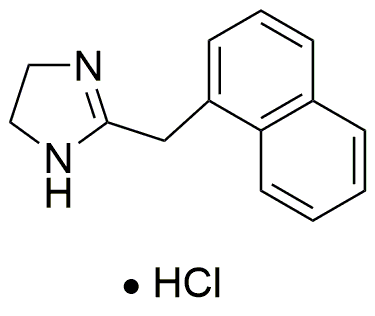Naphazoline hydrochloride is widely utilized in research focused on:
- Ophthalmology: Commonly used as a topical decongestant in eye drops to relieve redness and irritation caused by minor eye irritations.
- Rhinology: Employed in nasal sprays to reduce nasal congestion, making it beneficial for individuals suffering from allergies or colds.
- Pharmaceutical Development: Acts as a model compound in studies aimed at developing new medications for respiratory and ocular conditions.
- Veterinary Medicine: Utilized in certain veterinary applications to alleviate nasal congestion in animals, showcasing its versatility beyond human medicine.
- Research on Drug Interactions: Serves as a reference compound in pharmacological studies to understand interactions with other drugs, aiding in the development of safer therapeutic protocols.
General Information
Properties
Safety and Regulations
Applications
Naphazoline hydrochloride is widely utilized in research focused on:
- Ophthalmology: Commonly used as a topical decongestant in eye drops to relieve redness and irritation caused by minor eye irritations.
- Rhinology: Employed in nasal sprays to reduce nasal congestion, making it beneficial for individuals suffering from allergies or colds.
- Pharmaceutical Development: Acts as a model compound in studies aimed at developing new medications for respiratory and ocular conditions.
- Veterinary Medicine: Utilized in certain veterinary applications to alleviate nasal congestion in animals, showcasing its versatility beyond human medicine.
- Research on Drug Interactions: Serves as a reference compound in pharmacological studies to understand interactions with other drugs, aiding in the development of safer therapeutic protocols.
Documents
Safety Data Sheets (SDS)
The SDS provides comprehensive safety information on handling, storage, and disposal of the product.
Product Specification (PS)
The PS provides a comprehensive breakdown of the product’s properties, including chemical composition, physical state, purity, and storage requirements. It also details acceptable quality ranges and the product's intended applications.
Certificates of Analysis (COA)
Search for Certificates of Analysis (COA) by entering the products Lot Number. Lot and Batch Numbers can be found on a product’s label following the words ‘Lot’ or ‘Batch’.
*Catalog Number
*Lot Number
Certificates Of Origin (COO)
This COO confirms the country where the product was manufactured, and also details the materials and components used in it and whether it is derived from natural, synthetic, or other specific sources. This certificate may be required for customs, trade, and regulatory compliance.
*Catalog Number
*Lot Number
Safety Data Sheets (SDS)
The SDS provides comprehensive safety information on handling, storage, and disposal of the product.
DownloadProduct Specification (PS)
The PS provides a comprehensive breakdown of the product’s properties, including chemical composition, physical state, purity, and storage requirements. It also details acceptable quality ranges and the product's intended applications.
DownloadCertificates of Analysis (COA)
Search for Certificates of Analysis (COA) by entering the products Lot Number. Lot and Batch Numbers can be found on a product’s label following the words ‘Lot’ or ‘Batch’.
*Catalog Number
*Lot Number
Certificates Of Origin (COO)
This COO confirms the country where the product was manufactured, and also details the materials and components used in it and whether it is derived from natural, synthetic, or other specific sources. This certificate may be required for customs, trade, and regulatory compliance.


